Financial Analysis: Managing Resources at Tesco & Sainsbury's
VerifiedAdded on 2023/06/16
|16
|2412
|193
Report
AI Summary
This report provides a comparative analysis of financial resource management at Tesco and Sainsbury's, two major UK-based retail organizations. It delves into their financial performance, utilizing ratio analysis to assess liquidity, leverage, efficiency, and profitability. The report examines key financial metrics, including revenue, operating profit, and various balance sheet items, to provide insights into each company's financial health. Furthermore, it evaluates investment decisions by calculating the Return on Investment (ROI) for both companies, offering recommendations based on their financial standing. The analysis concludes that effective financial resource management is critical for organizational success, highlighting the importance of monitoring, cost analysis, and profitability improvement. Desklib offers students access to similar solved assignments and study resources.
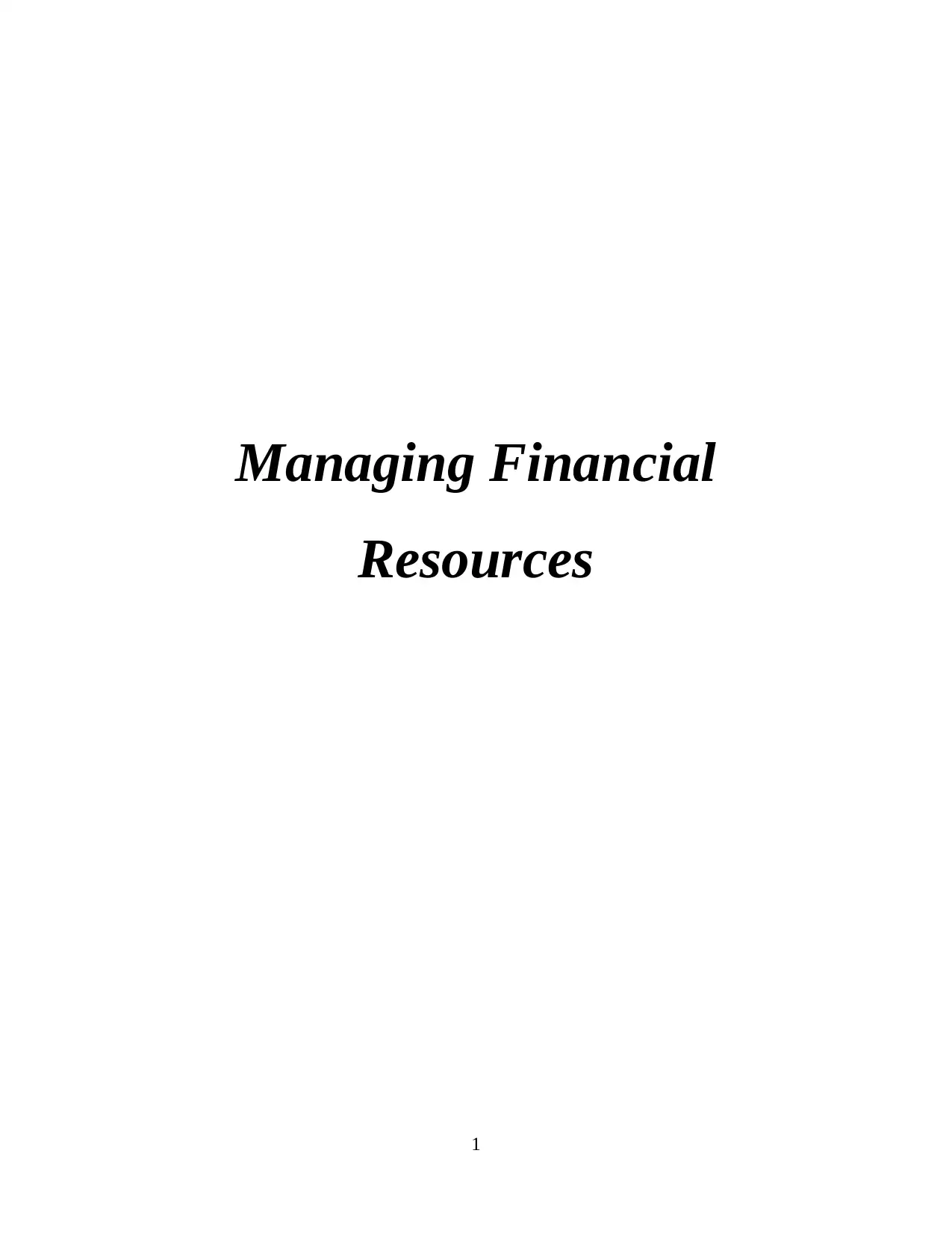
Managing Financial
Resources
1
Resources
1
Paraphrase This Document
Need a fresh take? Get an instant paraphrase of this document with our AI Paraphraser
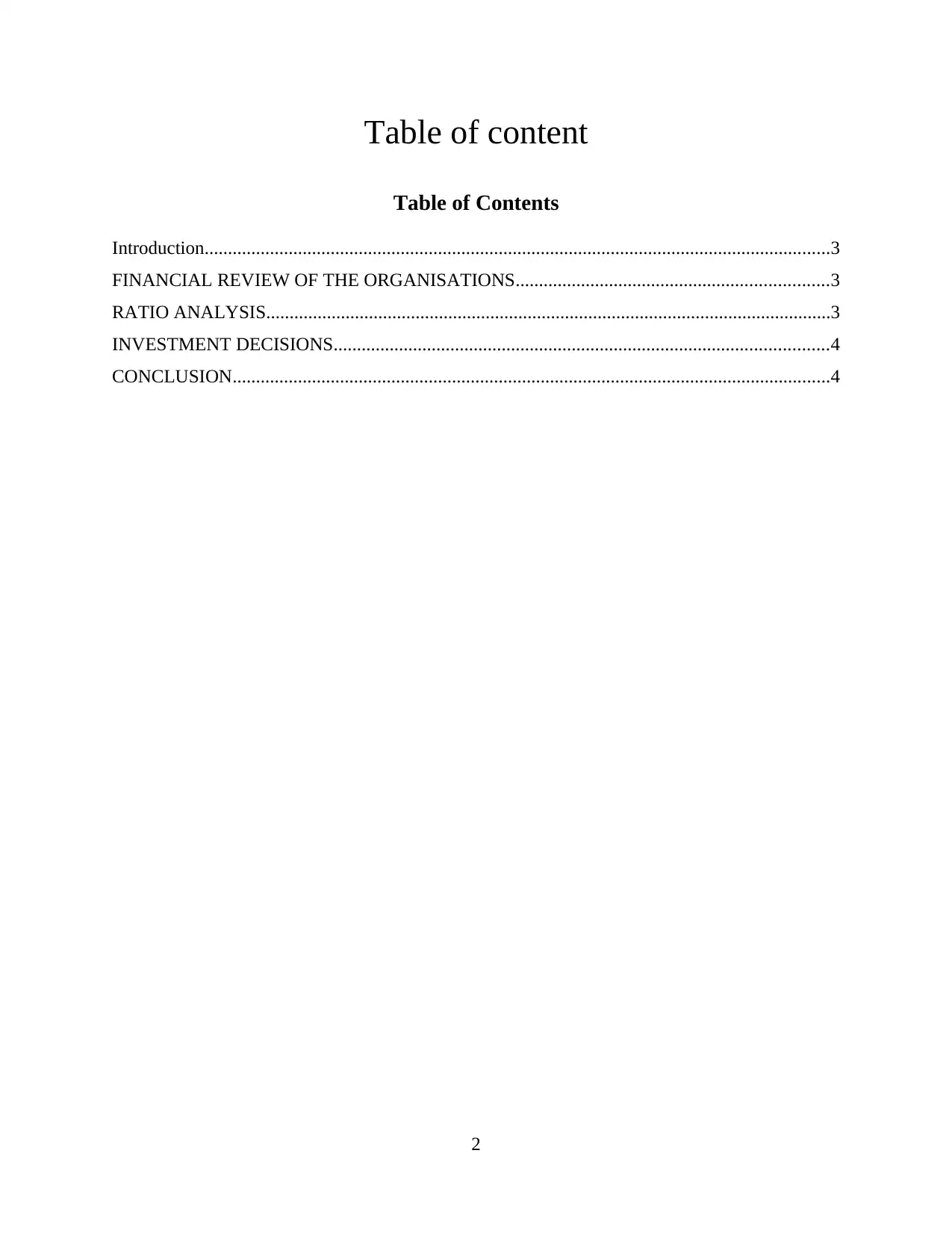
Table of content
Table of Contents
Introduction......................................................................................................................................3
FINANCIAL REVIEW OF THE ORGANISATIONS...................................................................3
RATIO ANALYSIS.........................................................................................................................3
INVESTMENT DECISIONS..........................................................................................................4
CONCLUSION................................................................................................................................4
2
Table of Contents
Introduction......................................................................................................................................3
FINANCIAL REVIEW OF THE ORGANISATIONS...................................................................3
RATIO ANALYSIS.........................................................................................................................3
INVESTMENT DECISIONS..........................................................................................................4
CONCLUSION................................................................................................................................4
2

Introduction
Managing the financial resources is a concept wherein the complicated issues in context
of financial planning along with the financial control are determined and resolved. The financial
resource management includes measurement of the performance on the basis of the cost analysis
along with the method of improving the profitability as well as techniques for financial
monitoring (Korzh, Mostenska and Bilan, 2017). The report revolves around the management of
the two organisation i.e. Tesco and Sainsbury's. Both of them are retail sector organisations.
Tesco is a multinational organisation that deals in groceries and general products. It is a UK
based retail sector organisation that has its headquarters at Welwyn Garden City, England. The
retail sector organisation was founded by jack Cohen in the year 1919 (Kolomytseva,
Medvedeva and Kolomiets, 2019). Sainsbury's is a UK based supermarket chain which was
founded in the year 1869. The organisation was founded by John James Sainsbury and the
headquarters of the organisation is established at London.
FINANCIAL REVIEW OF THE ORGANISATIONS
Financial Review of Tesco
In the financial year 2020 the annual revenue of Tesco amounted to nearly 53 billion
British pounds in the region of United Kingdom. There has been an increase in the revenue of the
organisation in comparison to the prior financial year of nearly one billion pounds. The profit of
Sainsbury's in the United Kingdom along with the return on investment has decreased to nearly
18.5 Million [Hand Greaves and Leadsdown, 2021].
Financial Review of Sainsbury's
Sainsbury's has achieved the low gearing score of 21.62% in the year 2018 that has
further decreased to 11.23% in the year 2019 which has been analysed as the impact of reduction
upon the business strategy to reduce the net debt. It has further witnessed the enhanced ability to
generate cash within the business in order to cover the interest along with the financial stability
of the business [Hand Greaves and Leadsdown, 2021].
3
Managing the financial resources is a concept wherein the complicated issues in context
of financial planning along with the financial control are determined and resolved. The financial
resource management includes measurement of the performance on the basis of the cost analysis
along with the method of improving the profitability as well as techniques for financial
monitoring (Korzh, Mostenska and Bilan, 2017). The report revolves around the management of
the two organisation i.e. Tesco and Sainsbury's. Both of them are retail sector organisations.
Tesco is a multinational organisation that deals in groceries and general products. It is a UK
based retail sector organisation that has its headquarters at Welwyn Garden City, England. The
retail sector organisation was founded by jack Cohen in the year 1919 (Kolomytseva,
Medvedeva and Kolomiets, 2019). Sainsbury's is a UK based supermarket chain which was
founded in the year 1869. The organisation was founded by John James Sainsbury and the
headquarters of the organisation is established at London.
FINANCIAL REVIEW OF THE ORGANISATIONS
Financial Review of Tesco
In the financial year 2020 the annual revenue of Tesco amounted to nearly 53 billion
British pounds in the region of United Kingdom. There has been an increase in the revenue of the
organisation in comparison to the prior financial year of nearly one billion pounds. The profit of
Sainsbury's in the United Kingdom along with the return on investment has decreased to nearly
18.5 Million [Hand Greaves and Leadsdown, 2021].
Financial Review of Sainsbury's
Sainsbury's has achieved the low gearing score of 21.62% in the year 2018 that has
further decreased to 11.23% in the year 2019 which has been analysed as the impact of reduction
upon the business strategy to reduce the net debt. It has further witnessed the enhanced ability to
generate cash within the business in order to cover the interest along with the financial stability
of the business [Hand Greaves and Leadsdown, 2021].
3
⊘ This is a preview!⊘
Do you want full access?
Subscribe today to unlock all pages.

Trusted by 1+ million students worldwide
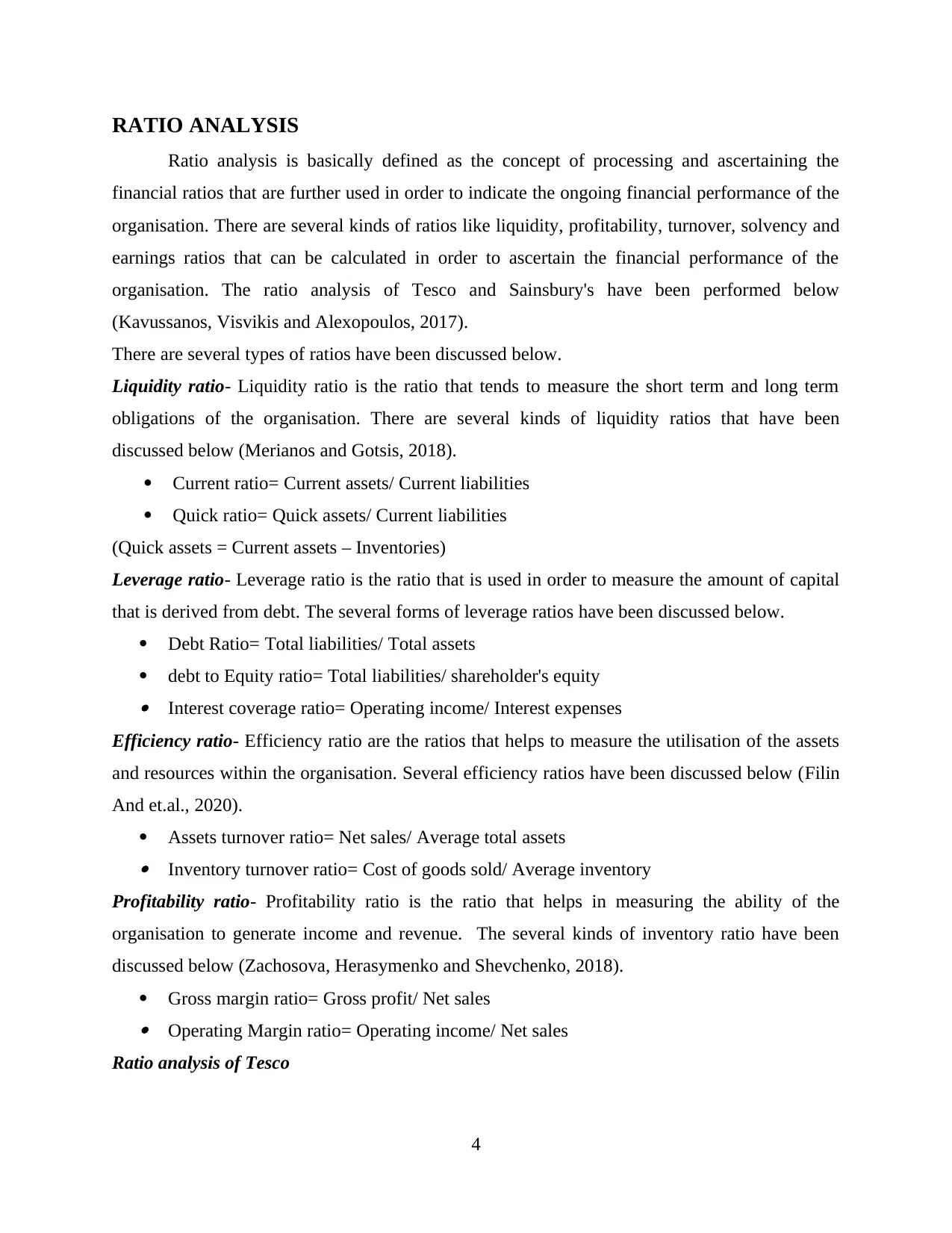
RATIO ANALYSIS
Ratio analysis is basically defined as the concept of processing and ascertaining the
financial ratios that are further used in order to indicate the ongoing financial performance of the
organisation. There are several kinds of ratios like liquidity, profitability, turnover, solvency and
earnings ratios that can be calculated in order to ascertain the financial performance of the
organisation. The ratio analysis of Tesco and Sainsbury's have been performed below
(Kavussanos, Visvikis and Alexopoulos, 2017).
There are several types of ratios have been discussed below.
Liquidity ratio- Liquidity ratio is the ratio that tends to measure the short term and long term
obligations of the organisation. There are several kinds of liquidity ratios that have been
discussed below (Merianos and Gotsis, 2018).
Current ratio= Current assets/ Current liabilities
Quick ratio= Quick assets/ Current liabilities
(Quick assets = Current assets – Inventories)
Leverage ratio- Leverage ratio is the ratio that is used in order to measure the amount of capital
that is derived from debt. The several forms of leverage ratios have been discussed below.
Debt Ratio= Total liabilities/ Total assets
debt to Equity ratio= Total liabilities/ shareholder's equity Interest coverage ratio= Operating income/ Interest expenses
Efficiency ratio- Efficiency ratio are the ratios that helps to measure the utilisation of the assets
and resources within the organisation. Several efficiency ratios have been discussed below (Filin
And et.al., 2020).
Assets turnover ratio= Net sales/ Average total assets Inventory turnover ratio= Cost of goods sold/ Average inventory
Profitability ratio- Profitability ratio is the ratio that helps in measuring the ability of the
organisation to generate income and revenue. The several kinds of inventory ratio have been
discussed below (Zachosova, Herasymenko and Shevchenko, 2018).
Gross margin ratio= Gross profit/ Net sales Operating Margin ratio= Operating income/ Net sales
Ratio analysis of Tesco
4
Ratio analysis is basically defined as the concept of processing and ascertaining the
financial ratios that are further used in order to indicate the ongoing financial performance of the
organisation. There are several kinds of ratios like liquidity, profitability, turnover, solvency and
earnings ratios that can be calculated in order to ascertain the financial performance of the
organisation. The ratio analysis of Tesco and Sainsbury's have been performed below
(Kavussanos, Visvikis and Alexopoulos, 2017).
There are several types of ratios have been discussed below.
Liquidity ratio- Liquidity ratio is the ratio that tends to measure the short term and long term
obligations of the organisation. There are several kinds of liquidity ratios that have been
discussed below (Merianos and Gotsis, 2018).
Current ratio= Current assets/ Current liabilities
Quick ratio= Quick assets/ Current liabilities
(Quick assets = Current assets – Inventories)
Leverage ratio- Leverage ratio is the ratio that is used in order to measure the amount of capital
that is derived from debt. The several forms of leverage ratios have been discussed below.
Debt Ratio= Total liabilities/ Total assets
debt to Equity ratio= Total liabilities/ shareholder's equity Interest coverage ratio= Operating income/ Interest expenses
Efficiency ratio- Efficiency ratio are the ratios that helps to measure the utilisation of the assets
and resources within the organisation. Several efficiency ratios have been discussed below (Filin
And et.al., 2020).
Assets turnover ratio= Net sales/ Average total assets Inventory turnover ratio= Cost of goods sold/ Average inventory
Profitability ratio- Profitability ratio is the ratio that helps in measuring the ability of the
organisation to generate income and revenue. The several kinds of inventory ratio have been
discussed below (Zachosova, Herasymenko and Shevchenko, 2018).
Gross margin ratio= Gross profit/ Net sales Operating Margin ratio= Operating income/ Net sales
Ratio analysis of Tesco
4
Paraphrase This Document
Need a fresh take? Get an instant paraphrase of this document with our AI Paraphraser

Income
Statement:
07/03/20 09/03/19 10/03/18 11/03/17
£ (Millions) £ (Millions) £ (Millions) £ (Millions)
Revenue: 28993 29007 28456 26224
Operating Profit /
(Loss):
650 601 518 642
Net Interest: -366 -403 -121 -102
Profit Before Tax: 255 202 409 503
Profit after tax
from continuing
operations:
152 186 309 377
Discontinued
Operations:
Profit after tax
from
discontinuing
operations:
- - - -
Profit for the
period:
152 186 309 377
Attributable to:
Equity holders of
parent company:
152 186 309 377
Minority Interests
/ Other Equity:
- - - -
Total Dividend
Paid:
- - - -
Retained Profit / - - - -
5
Statement:
07/03/20 09/03/19 10/03/18 11/03/17
£ (Millions) £ (Millions) £ (Millions) £ (Millions)
Revenue: 28993 29007 28456 26224
Operating Profit /
(Loss):
650 601 518 642
Net Interest: -366 -403 -121 -102
Profit Before Tax: 255 202 409 503
Profit after tax
from continuing
operations:
152 186 309 377
Discontinued
Operations:
Profit after tax
from
discontinuing
operations:
- - - -
Profit for the
period:
152 186 309 377
Attributable to:
Equity holders of
parent company:
152 186 309 377
Minority Interests
/ Other Equity:
- - - -
Total Dividend
Paid:
- - - -
Retained Profit / - - - -
5
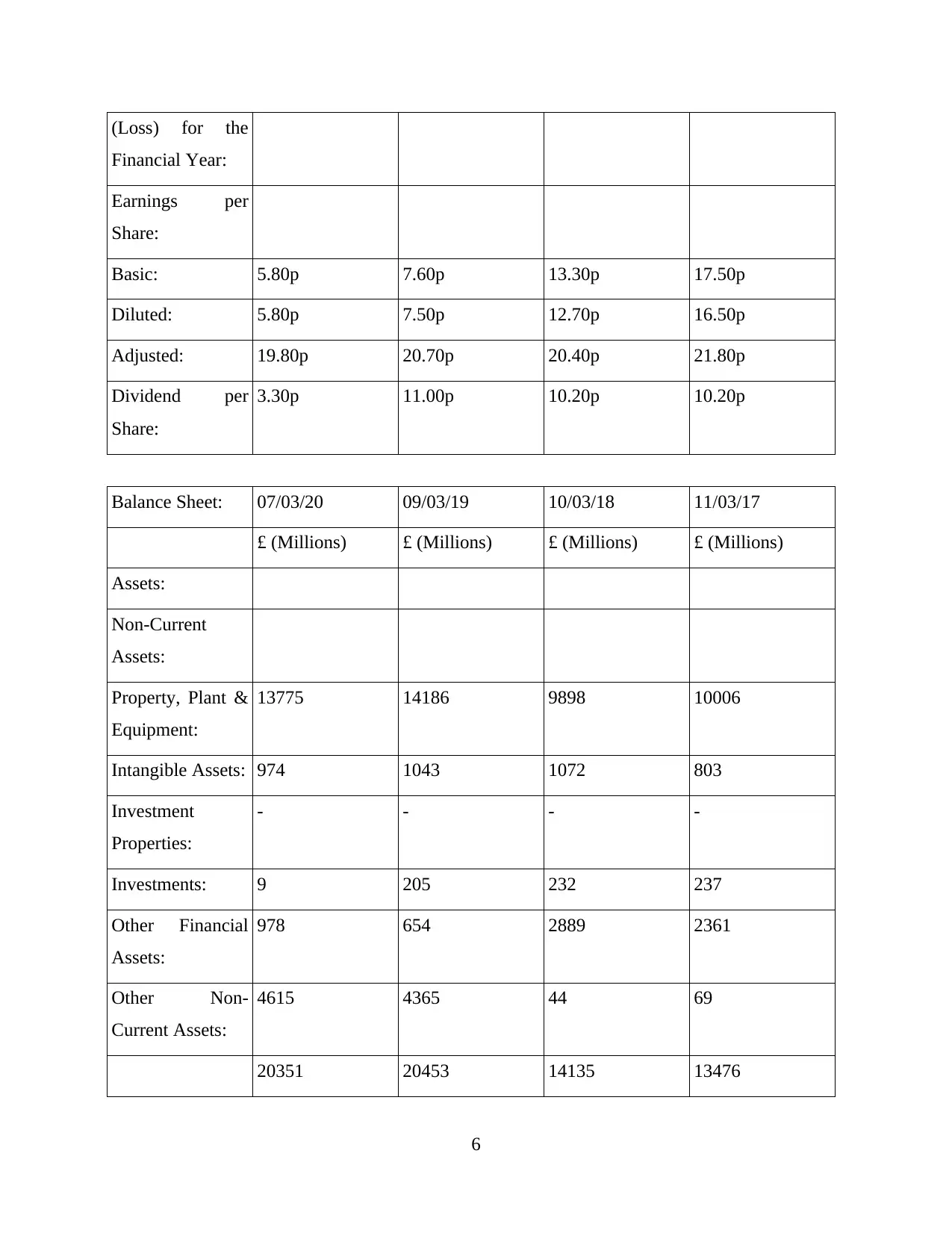
(Loss) for the
Financial Year:
Earnings per
Share:
Basic: 5.80p 7.60p 13.30p 17.50p
Diluted: 5.80p 7.50p 12.70p 16.50p
Adjusted: 19.80p 20.70p 20.40p 21.80p
Dividend per
Share:
3.30p 11.00p 10.20p 10.20p
Balance Sheet: 07/03/20 09/03/19 10/03/18 11/03/17
£ (Millions) £ (Millions) £ (Millions) £ (Millions)
Assets:
Non-Current
Assets:
Property, Plant &
Equipment:
13775 14186 9898 10006
Intangible Assets: 974 1043 1072 803
Investment
Properties:
- - - -
Investments: 9 205 232 237
Other Financial
Assets:
978 654 2889 2361
Other Non-
Current Assets:
4615 4365 44 69
20351 20453 14135 13476
6
Financial Year:
Earnings per
Share:
Basic: 5.80p 7.60p 13.30p 17.50p
Diluted: 5.80p 7.50p 12.70p 16.50p
Adjusted: 19.80p 20.70p 20.40p 21.80p
Dividend per
Share:
3.30p 11.00p 10.20p 10.20p
Balance Sheet: 07/03/20 09/03/19 10/03/18 11/03/17
£ (Millions) £ (Millions) £ (Millions) £ (Millions)
Assets:
Non-Current
Assets:
Property, Plant &
Equipment:
13775 14186 9898 10006
Intangible Assets: 974 1043 1072 803
Investment
Properties:
- - - -
Investments: 9 205 232 237
Other Financial
Assets:
978 654 2889 2361
Other Non-
Current Assets:
4615 4365 44 69
20351 20453 14135 13476
6
⊘ This is a preview!⊘
Do you want full access?
Subscribe today to unlock all pages.

Trusted by 1+ million students worldwide
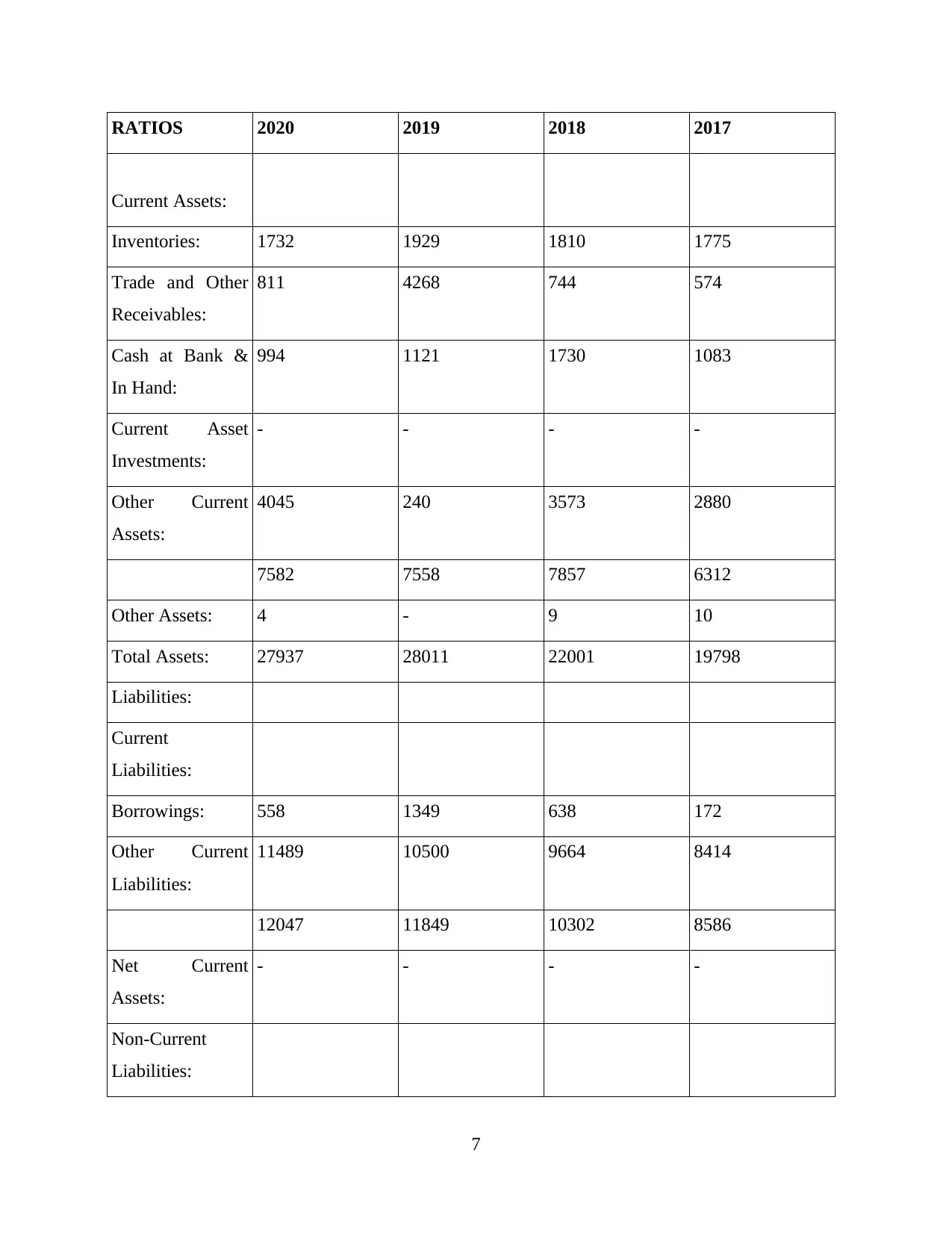
RATIOS 2020 2019 2018 2017
Current Assets:
Inventories: 1732 1929 1810 1775
Trade and Other
Receivables:
811 4268 744 574
Cash at Bank &
In Hand:
994 1121 1730 1083
Current Asset
Investments:
- - - -
Other Current
Assets:
4045 240 3573 2880
7582 7558 7857 6312
Other Assets: 4 - 9 10
Total Assets: 27937 28011 22001 19798
Liabilities:
Current
Liabilities:
Borrowings: 558 1349 638 172
Other Current
Liabilities:
11489 10500 9664 8414
12047 11849 10302 8586
Net Current
Assets:
- - - -
Non-Current
Liabilities:
7
Current Assets:
Inventories: 1732 1929 1810 1775
Trade and Other
Receivables:
811 4268 744 574
Cash at Bank &
In Hand:
994 1121 1730 1083
Current Asset
Investments:
- - - -
Other Current
Assets:
4045 240 3573 2880
7582 7558 7857 6312
Other Assets: 4 - 9 10
Total Assets: 27937 28011 22001 19798
Liabilities:
Current
Liabilities:
Borrowings: 558 1349 638 172
Other Current
Liabilities:
11489 10500 9664 8414
12047 11849 10302 8586
Net Current
Assets:
- - - -
Non-Current
Liabilities:
7
Paraphrase This Document
Need a fresh take? Get an instant paraphrase of this document with our AI Paraphraser

Borrowings: 6512 6142 1602 2039
Provisions: 354 330 407 348
Other Non-
Current
Liabilities:
1251 1908 2279 1953
8117 8380 4288 4340
Other Liabilities: - - - -
Total Liabilities: 20164 20229 14590 12926
Net Assets: 7773 7782 7411 6872
Capital &
reserves:
Share Capital: 634 630 627 625
Share Premium
Account:
1159 1147 1130 1120
Other Reserves: 1416 1916 1865 1937
Retained
Earnings:
4068 4089 3789 3190
Shareholders
Funds:
7277 7782 7411 6872
Minority Interests
/ Other Equity:
496 - - -
Total Equity: 7773 7782 7411 6872
CURRENT
RATIO
0.63 0.64 0.76 0.74
8
Provisions: 354 330 407 348
Other Non-
Current
Liabilities:
1251 1908 2279 1953
8117 8380 4288 4340
Other Liabilities: - - - -
Total Liabilities: 20164 20229 14590 12926
Net Assets: 7773 7782 7411 6872
Capital &
reserves:
Share Capital: 634 630 627 625
Share Premium
Account:
1159 1147 1130 1120
Other Reserves: 1416 1916 1865 1937
Retained
Earnings:
4068 4089 3789 3190
Shareholders
Funds:
7277 7782 7411 6872
Minority Interests
/ Other Equity:
496 - - -
Total Equity: 7773 7782 7411 6872
CURRENT
RATIO
0.63 0.64 0.76 0.74
8
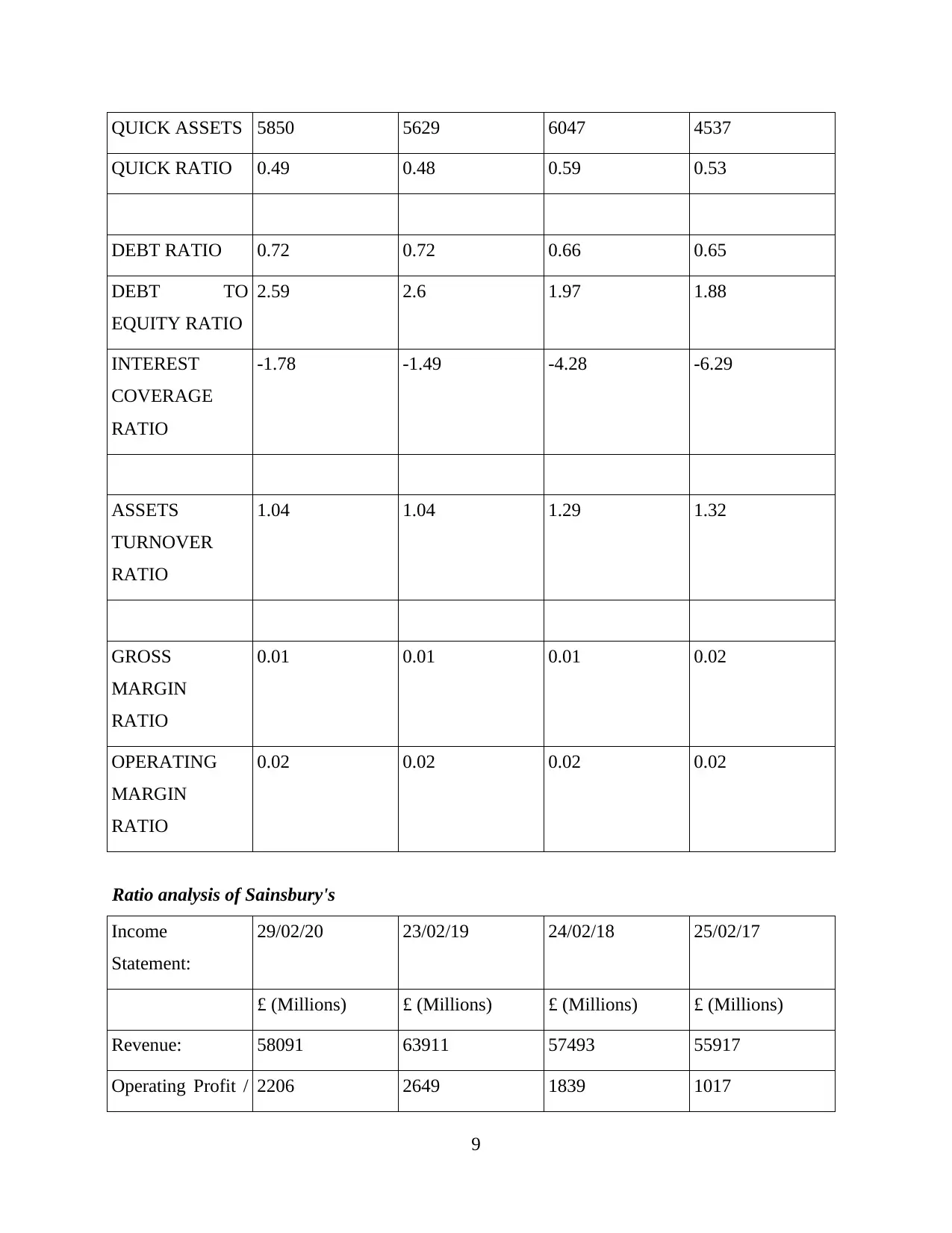
QUICK ASSETS 5850 5629 6047 4537
QUICK RATIO 0.49 0.48 0.59 0.53
DEBT RATIO 0.72 0.72 0.66 0.65
DEBT TO
EQUITY RATIO
2.59 2.6 1.97 1.88
INTEREST
COVERAGE
RATIO
-1.78 -1.49 -4.28 -6.29
ASSETS
TURNOVER
RATIO
1.04 1.04 1.29 1.32
GROSS
MARGIN
RATIO
0.01 0.01 0.01 0.02
OPERATING
MARGIN
RATIO
0.02 0.02 0.02 0.02
Ratio analysis of Sainsbury's
Income
Statement:
29/02/20 23/02/19 24/02/18 25/02/17
£ (Millions) £ (Millions) £ (Millions) £ (Millions)
Revenue: 58091 63911 57493 55917
Operating Profit / 2206 2649 1839 1017
9
QUICK RATIO 0.49 0.48 0.59 0.53
DEBT RATIO 0.72 0.72 0.66 0.65
DEBT TO
EQUITY RATIO
2.59 2.6 1.97 1.88
INTEREST
COVERAGE
RATIO
-1.78 -1.49 -4.28 -6.29
ASSETS
TURNOVER
RATIO
1.04 1.04 1.29 1.32
GROSS
MARGIN
RATIO
0.01 0.01 0.01 0.02
OPERATING
MARGIN
RATIO
0.02 0.02 0.02 0.02
Ratio analysis of Sainsbury's
Income
Statement:
29/02/20 23/02/19 24/02/18 25/02/17
£ (Millions) £ (Millions) £ (Millions) £ (Millions)
Revenue: 58091 63911 57493 55917
Operating Profit / 2206 2649 1839 1017
9
⊘ This is a preview!⊘
Do you want full access?
Subscribe today to unlock all pages.

Trusted by 1+ million students worldwide
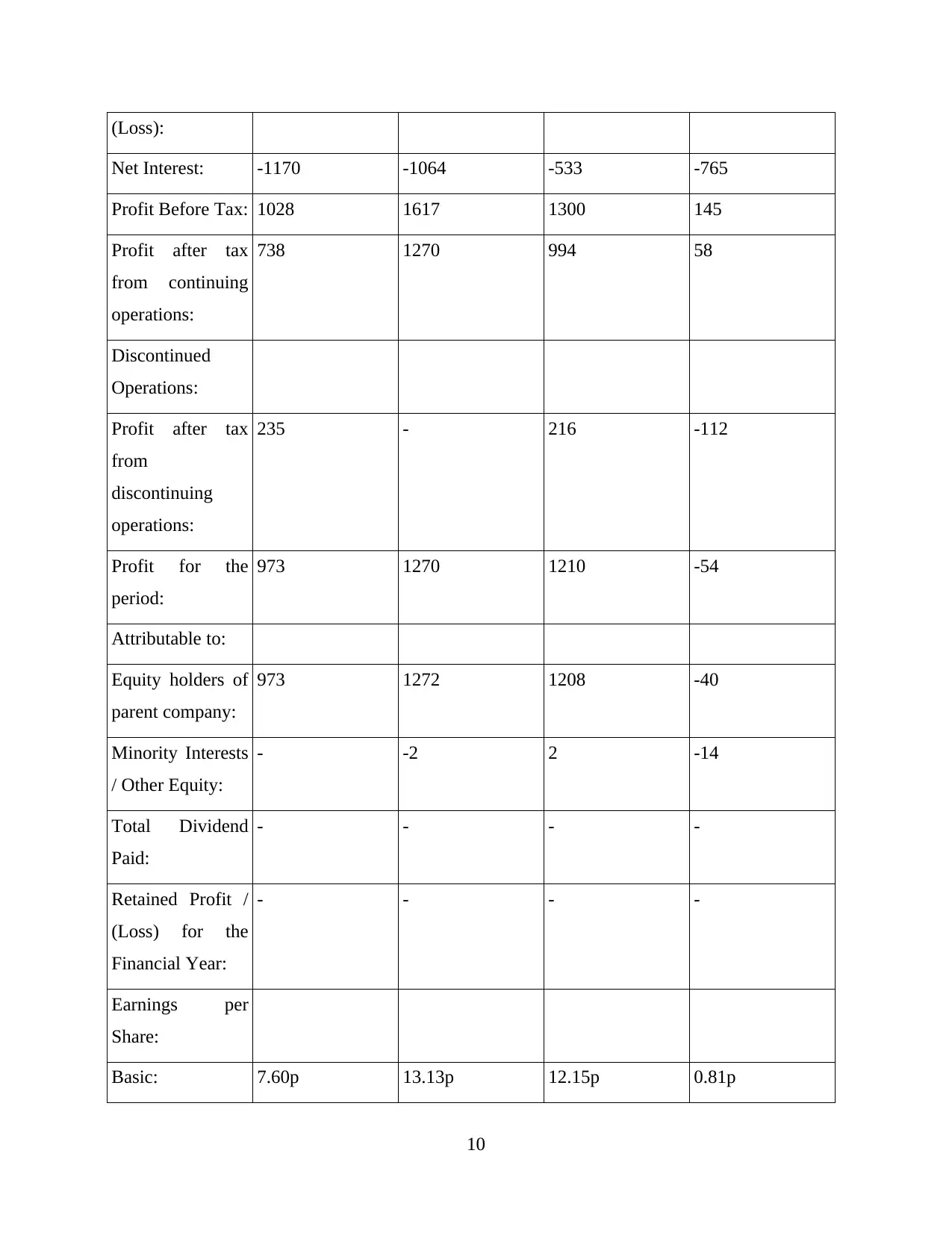
(Loss):
Net Interest: -1170 -1064 -533 -765
Profit Before Tax: 1028 1617 1300 145
Profit after tax
from continuing
operations:
738 1270 994 58
Discontinued
Operations:
Profit after tax
from
discontinuing
operations:
235 - 216 -112
Profit for the
period:
973 1270 1210 -54
Attributable to:
Equity holders of
parent company:
973 1272 1208 -40
Minority Interests
/ Other Equity:
- -2 2 -14
Total Dividend
Paid:
- - - -
Retained Profit /
(Loss) for the
Financial Year:
- - - -
Earnings per
Share:
Basic: 7.60p 13.13p 12.15p 0.81p
10
Net Interest: -1170 -1064 -533 -765
Profit Before Tax: 1028 1617 1300 145
Profit after tax
from continuing
operations:
738 1270 994 58
Discontinued
Operations:
Profit after tax
from
discontinuing
operations:
235 - 216 -112
Profit for the
period:
973 1270 1210 -54
Attributable to:
Equity holders of
parent company:
973 1272 1208 -40
Minority Interests
/ Other Equity:
- -2 2 -14
Total Dividend
Paid:
- - - -
Retained Profit /
(Loss) for the
Financial Year:
- - - -
Earnings per
Share:
Basic: 7.60p 13.13p 12.15p 0.81p
10
Paraphrase This Document
Need a fresh take? Get an instant paraphrase of this document with our AI Paraphraser
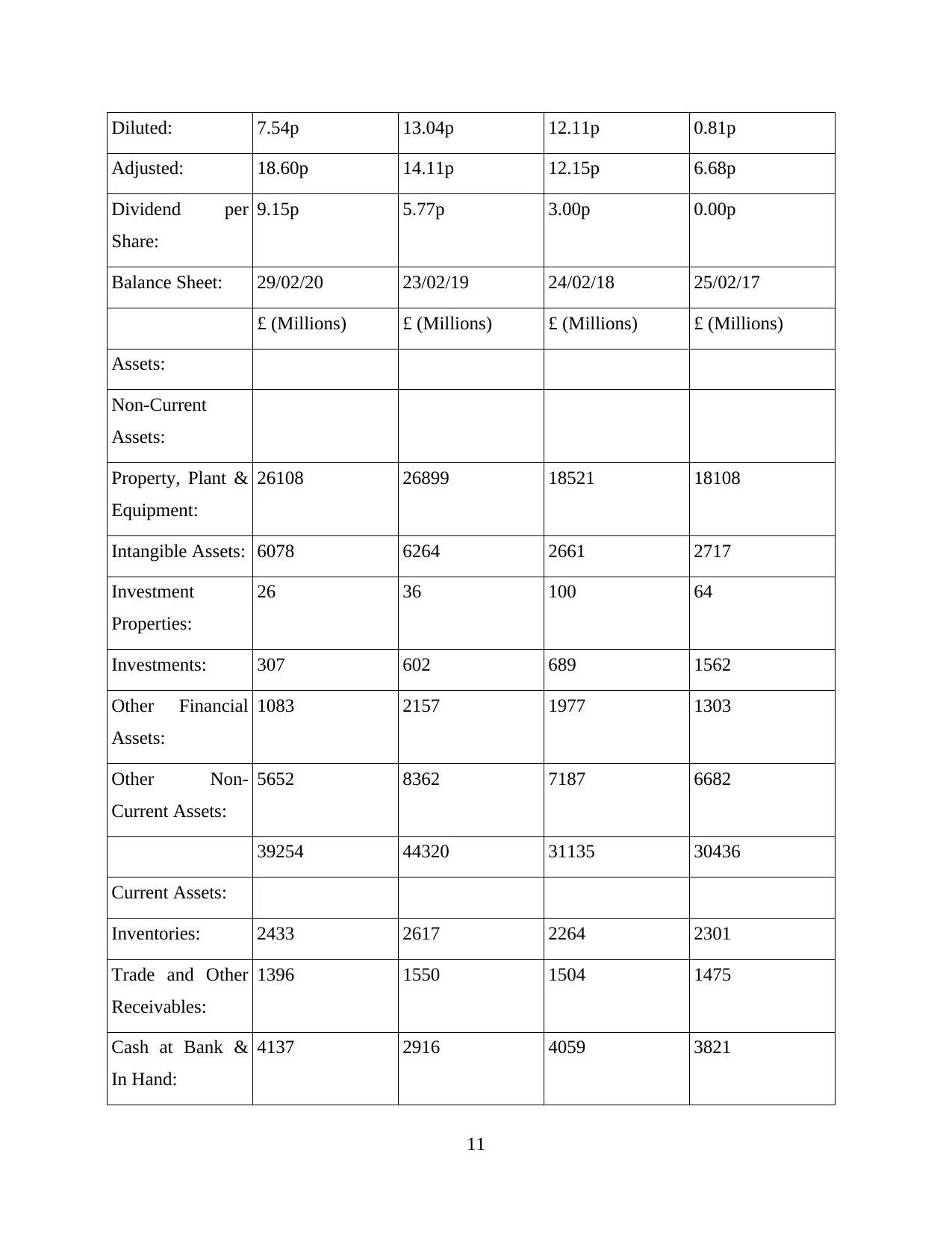
Diluted: 7.54p 13.04p 12.11p 0.81p
Adjusted: 18.60p 14.11p 12.15p 6.68p
Dividend per
Share:
9.15p 5.77p 3.00p 0.00p
Balance Sheet: 29/02/20 23/02/19 24/02/18 25/02/17
£ (Millions) £ (Millions) £ (Millions) £ (Millions)
Assets:
Non-Current
Assets:
Property, Plant &
Equipment:
26108 26899 18521 18108
Intangible Assets: 6078 6264 2661 2717
Investment
Properties:
26 36 100 64
Investments: 307 602 689 1562
Other Financial
Assets:
1083 2157 1977 1303
Other Non-
Current Assets:
5652 8362 7187 6682
39254 44320 31135 30436
Current Assets:
Inventories: 2433 2617 2264 2301
Trade and Other
Receivables:
1396 1550 1504 1475
Cash at Bank &
In Hand:
4137 2916 4059 3821
11
Adjusted: 18.60p 14.11p 12.15p 6.68p
Dividend per
Share:
9.15p 5.77p 3.00p 0.00p
Balance Sheet: 29/02/20 23/02/19 24/02/18 25/02/17
£ (Millions) £ (Millions) £ (Millions) £ (Millions)
Assets:
Non-Current
Assets:
Property, Plant &
Equipment:
26108 26899 18521 18108
Intangible Assets: 6078 6264 2661 2717
Investment
Properties:
26 36 100 64
Investments: 307 602 689 1562
Other Financial
Assets:
1083 2157 1977 1303
Other Non-
Current Assets:
5652 8362 7187 6682
39254 44320 31135 30436
Current Assets:
Inventories: 2433 2617 2264 2301
Trade and Other
Receivables:
1396 1550 1504 1475
Cash at Bank &
In Hand:
4137 2916 4059 3821
11

Current Asset
Investments:
1076 390 1029 3011
Other Current
Assets:
4566 5007 4744 4465
13608 12480 13600 15073
Other Assets: 285 98 149 344
Total Assets: 53147 56898 44884 45853
Liabilities:
Current
Liabilities:
Borrowings: 2817 2209 1479 2560
Other Current
Liabilities:
15839 18764 17754 16674
18656 20973 19233 19234
Net Current
Assets:
- - - -
Non-Current
Liabilities:
Borrowings: 14973 15439 7142 9433
Provisions: 177 196 817 773
Other Non-
Current
Liabilities:
5972 6858 7212 9828
21122 22493 15171 20034
Other Liabilities: - - - 171
Total Liabilities: 39778 43466 34404 39439
12
Investments:
1076 390 1029 3011
Other Current
Assets:
4566 5007 4744 4465
13608 12480 13600 15073
Other Assets: 285 98 149 344
Total Assets: 53147 56898 44884 45853
Liabilities:
Current
Liabilities:
Borrowings: 2817 2209 1479 2560
Other Current
Liabilities:
15839 18764 17754 16674
18656 20973 19233 19234
Net Current
Assets:
- - - -
Non-Current
Liabilities:
Borrowings: 14973 15439 7142 9433
Provisions: 177 196 817 773
Other Non-
Current
Liabilities:
5972 6858 7212 9828
21122 22493 15171 20034
Other Liabilities: - - - 171
Total Liabilities: 39778 43466 34404 39439
12
⊘ This is a preview!⊘
Do you want full access?
Subscribe today to unlock all pages.

Trusted by 1+ million students worldwide
1 out of 16
Related Documents
Your All-in-One AI-Powered Toolkit for Academic Success.
+13062052269
info@desklib.com
Available 24*7 on WhatsApp / Email
![[object Object]](/_next/static/media/star-bottom.7253800d.svg)
Unlock your academic potential
Copyright © 2020–2025 A2Z Services. All Rights Reserved. Developed and managed by ZUCOL.





